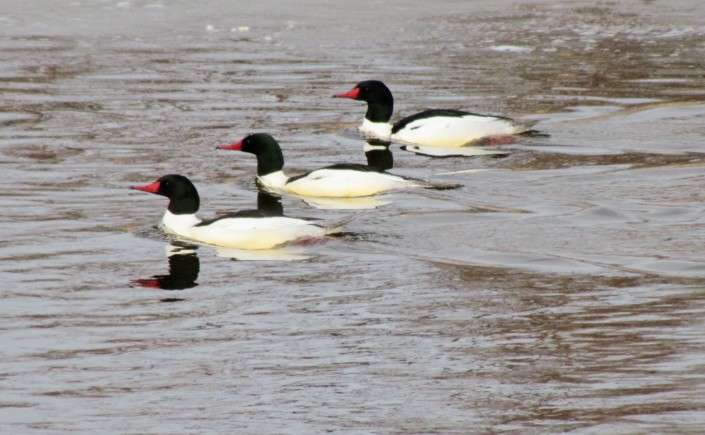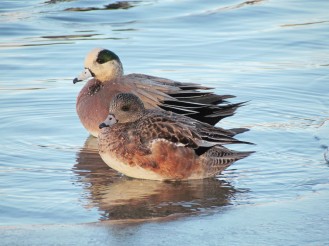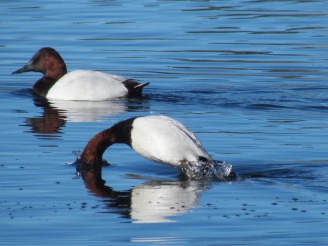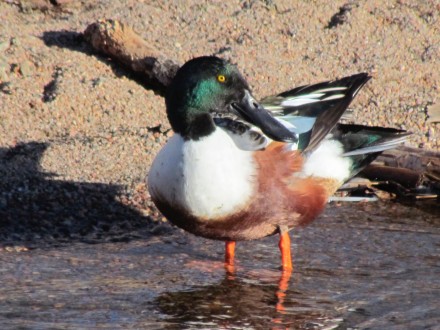…to our winter waterfowl. Most overwintering species have taken off in the last several weeks for their breeding grounds in more northern latitudes, even though a few stragglers are still lingering, and some will not leave at all.
Es ist an der Zeit, auf Wiedersehen zu unseren Winterwassergästen zu sagen. Die meisten hier überwinternden Entenarten haben sich in den vergangenen Wochen in nördlichere Gefilde zu ihren Brutstätten aufgemacht, obwohl einige noch hinterherhinken, und manche uns überhaupt nicht verlassen werden.
Time not only to say goodbye, but thank you. When many birds fly south and leave a gaping void in autumn, this void is filled, at least partly, by the arrival of an assortment of ducks, whose presence brightens the short, dark days of my least favorite season.
Es ist nicht nur an der Zeit, auf Wiedersehen zu sagen, sondern auch Dankeschön. Denn wenn viele unserer Vögel im Herbst gen Süden fliegen, und eine gähnende Leere hinterlassen, wird diese Leere wenigstens teilweise von einer Auswahl an Enten gefüllt, deren Präsenz die kurzen, dunklen Tage meiner unbeliebtesten Jahreszeit erhellen.
I will not provide details about life cycles or migratory routes of the individuals presented here, which are available in any printed or online birding guide, other than to say that most ducks who spend the winter here, arrive between September and November, and leave again between February and April, when they point their beaks north, some as far north as the Canadian or Alaskan Arctic, where they will mate, incubate their eggs, and care for their young.
Ich beschränke mich auf wenige Details der Lebenszyklen und Wanderrouten der hier vorgestellten Individuen, die in jedem gedruckten oder computerbasierten Vogelführer zu finden sind. Die meisten Entenvögel, die hier den Winter verbringen, kommen zwischen September und November an, und verlassen uns zwischen Februar und April. Dann richten sie ihre Schnäbel gen Norden, teilweise bis ins arktische Kanada oder Alaska, wo sie sich paaren, ihre Gelege hüten, und ihren Nachwuchs aufziehen.
Without having conducted any scientific research or consulted any statistical data, my impression is that Mallards are the most common ducks not only in El Paso County, but possibly in the country. They are year-round residents, but I include them in my review because the males’ conspicuous colors and the females’ conspicuous quacks are a joy to behold any time of the year.
Ohne wissenschaftliche Studien betrieben oder statistische Tabellen konsultiert zu haben, sind Stockenten wahrscheinlich die häufigsten Enten nicht nur hier im Bezirk, sondern im ganzen Land. Sie gehören zu unseren Standvögeln, aber ich erwähne sie trotzdem, weil die bunten Farben des Erpels und das auffällige Quaken seiner Dame zu jeglicher Jahreszeit Freude bereiten.
To enlarge a photo, click on it. To read its caption, hover cursor over it.
Zum Vergrößern, das Bild bitte anklicken. Um den Titel zu lesen, mit der Maus darüber schweben.
Gadwall might be the least distinctive of all our ducks, but I like their understated style.
Schnatterenten zählen vielleicht zu den unauffälligsten Enten, aber mir gefällt ihr dezenter Stil.
American Wigeons always put me in a good mood. The males have a gorgeous green eye patch and white crown, a feature responsible for their old name, “baldpate.” Their whistling calls enliven any winter lake.
Nordamerikanische Pfeifenten machen immer gute Laune. Die Männchen haben einen großartigen grünen Augenstreif und eine weiße Krone, die für ihren alten Namen, Kahlkopf, verantwortlich war. Ihr Pfeifen belebt jeden winterlichen See.
Any bird with a head this color will automatically become a favorite: Meet the Redhead.
Jeglicher Vogel mit einer solchen Kopffärbung ist automatisch beliebt. Darf ich vorstellen: Die Rotkopfente.
Canvasbacks resemble Redheads, but note the different shape of the head. I think they look particularly graceful.
Riesentafelenten ähneln Rotkopfenten, doch ist die Kopfform unterschiedlich. Ich finde sie besonders graziös.
Ruddy Ducks are only ruddy during the breeding season when the male is nearly red (see first photo) with a blue beak (see second photo).
Schwarzkopf-Ruderenten sind nur während der Brutsaison rot (siehe erstes Photo), und das Männchen bekommt einen blauen Schnabel (siehe zweites Photo).
Lesser Scaup are quite common and can be confused with their cousin, Greater Scaup. I have trouble telling them apart. I think these are Lesser Scaup. 🙂
Kleine Bergenten sind häufig zu sehen und können mit (Großen) Bergenten verwechselt werden. Ich glaube, hier handelt es sich um kleine. 🙂
Ring-necked Ducks are similarly patterned as Lesser Scaup, but notice the white vertical crescent along the flank of the male. They should really be called Ring-billed Ducks, as the ring around the neck can only be seen when the bird is dead, and the ring around the beak when the bird is alive.
Halsringenten ähneln kleinen Bergenten, aber die Männchen haben einen weißen vertikalen Halbmond an der Flanke. Ringschnabelente wäre eine bessere Bezeichnung, denn der Ring am Hals ist nur an toten Enten zu sehen, doch der Ring am Schnabel, an lebendigen.
Common Goldeneye do their name justice.
Schellenten machen ihrem Namen im Englischen Ehre (Goldaugen). Ich weiß nicht, worauf sich der deutsche Name bezieht.
Bufflehead are so called because the massive bulbous head of the male reminded someone of buffalo. They are great divers and seem to spend more time under the water than on top.
Büffelkopfenten erinnerten die ersten Beschreiber an Büffel. Sie sind gute Taucher und scheinen mehr Zeit unter Wasser zu verbringen als obendrauf.
Common Mergansers are anything but common. The classy appearance of the three males gliding through the featured photo above, as well as the females’ headdress should convince you, too.
Gänsesäger sind bemerkenswert, wie die klassischen Klamotten der Herren ganz oben im Bild und der fantastische Kopfputz der Damen beweisen.
Hooded Mergansers also wear great hairdos and are a beautiful adornment to any body of water.
Auch Kappensäger haben faszinierende Frisuren und sind Zierde eines jeglichen Gewässers.
Green-winged Teals are our smallest ducks, but this can only be appreciated when seen next to other waterfowl.
Amerikanische Krickenten sind unsere kleinsten Enten, aber das sieht man eigentlich nur im Vergleich mit anderen Wasservögeln.
Northern Pintails are elegance personified. Enough said.
Spießenten sind von erlesener Eleganz. Mehr ist dazu nicht zu sagen.
Last, but not least, Northern Shovelers. The size of their bills is astounding. They often go round and round in circles while dabbling in the water, which has led me to call them the “Whirling Dervishes.”
Zu guter Letzt: Löffelenten. Ihre Schnäbel sind frappant. Sie drehen sich so oft im Kreis während sie gründeln, daß ich sie tanzende Derwische getauft habe.
Spring migration, while it promises the arrival of those feathered friends that left us last fall, also means the departure of our darling ducks. It’s time not only to say goodbye and thank you, but also good luck. Good luck with all the challenges that await you. I hope with all my heart to welcome you and your offspring again later this year.
Auch wenn der Frühjahrszug die Ankunft der gefiederten Freunde verheißt, die uns vergangenen Herbst verlassen haben, bedeutet er auch die Abreise unserer entzückenden Enten. Es ist nicht nur an der Zeit, auf Wiedersehen und Dankeschön zu sagen, sondern auch viel Glück. Viel Glück mit all den Herausforderungen, die auf Euch warten. Ich hoffe von ganzem Herzen, Euch und Euren Nachwuchs später im Jahr wieder willkommen zu heißen.

































Das ist die Natur. Manche gehen. Andere kommen. Wieder sehr schöne Bilder. Vielen Dank. Macht Spaß sich die anzusehen.
LG Jürgen
LikeLiked by 4 people
Das stimmt, lieber Jürgen, aber der Abschied fällt immer etwas schwer. Wer weiß, was in der Zwischenzeit alles passieren kann.
Es freut mich, daß Dir die Bilder gefallen haben.
Herzliche Grüße,
Tanja
LikeLike
Das ist wohl so, aber umso größer die Freude, wenn sie zurück kommen.
LG Jürgen
LikeLiked by 1 person
Allerdings!
LikeLike
Danke für den schönen Rundgang durch die große Entenvielfalt, liebe Tanja!!
LikeLiked by 3 people
Danke für die nette Begleitung, liebe Simone. Vielleicht müssen wir den Rundgang irgendwann fortsetzen, denn es gibt noch viel mehr. 😊
Herzliche Grüße,
Tanja
LikeLiked by 1 person
So viele schöne Enten! Es war mir gar nicht bewusst, dass es so viele unterschiedliche gibt ….
LikeLiked by 1 person
…und das sind noch längst nicht alle! 😊
LikeLike
What a fantastic selection of quackers! The Buffleheads are great, we only see them in collections.
Never fear they will all return, each season has it’s joys.
LikeLiked by 1 person
Thank you, Brian. I know that everything has its season, but their departure still leaves me slightly wistful. 🦆
LikeLiked by 1 person
Hello Tanja,
Like you, winter is not my favourite season. But as you say, these ducks have provided many hours of “joy” during the coldest months. I wish them safe travels and hope to see them again next year. And thank you for sharing such a thoughtful post with beautiful photos.
Best wishes,
Takami
LikeLiked by 1 person
I am glad that we share the same appreciation for our respective winter ducks, Takami. Seeing them really brightens the dark days.
I hope you are well.
Kindest regards,
Tanja 🦆
LikeLiked by 1 person
Hübsche Enten sind das. Manche kenne ich, andere kommen hier nicht vor. Stockenten sind meine Favoriten.
LikeLiked by 1 person
Ich liebe sie alle, liebe Brigitte, und es wäre schwer, einen einzigen Favoriten herauszusuchen. Was ich an Stockenten so toll finde, ist daß sie in jeder Pfütze zu jeder Jahreszeit zu finden sind, und ich sofort besser fühle, wenn ich sie sehe. 🦆🦆🦆
LikeLike
I looked to see if I could find
The origin of widgeon.
Unknown, say books, but never mind,
At least it rhymes with pigeon.
LikeLiked by 1 person
I wish I could rhyme
But it takes too much time.
The spelling of wigeon
Corresponds to that of pigeon.
But what the name ,may portend
Puts me at my wits’ end.
LikeLiked by 1 person
I also have to ask whether your post’s title alludes to a certain song.
LikeLiked by 1 person
The song had definitely crossed my mind, Steve. I thought of Sarah Brightman’s version, but then I found this:
LikeLiked by 1 person
That’s the duet I was thinking of.
LikeLiked by 1 person
Uh oh. The title of this piece had me worried. You better not have any plans to hang up your writing implements!
LikeLiked by 1 person
I take that as a compliment, Neil, thank you. No plans to let my quill dry up. 🙂
LikeLiked by 1 person
Good!
LikeLiked by 1 person
😊
LikeLiked by 1 person
Great photos!
LikeLiked by 1 person
Thank you, JoAnn, I am glad you like them. 🦆
LikeLiked by 1 person
What great photos! I think you covered every species except for the Wood Duck! My favorite is the Bufflehead…so cute!
LikeLiked by 1 person
Not quite every species, Valerie, but a lot. Wood ducks don’t overwinter here, which is why I didn’t include them. Buffleheads are tiny compared to some of the others, and always busy. I love them, too, but then I love them all. 🙂
LikeLiked by 1 person
Yes, they are all beautiful!!!
LikeLiked by 1 person
🦆
LikeLike
This is quite an assortment of ducks!!
As we always have the Common Merganser at the lake up north (once it is no longer frozen!) I like to think, that they are coming over from your region!😉
LikeLiked by 1 person
Wonderful to see the names in German!
LikeLiked by 1 person
It’s always good practice for me having to look them up, Cathy. I am glad you enjoyed them, too.
LikeLike
Wunderschöne Fotos und was für eine Vielzahl an wunderschönen Enten! Danke für diese schöne Serie liebe Tanja. LG, Almuth
LikeLiked by 1 person
Es freut mich, daß Dir die entzückenden Enten gefallen haben, liebe Almuth. Danke für die nette Rückmeldung.
Liebe Grüße.
Tanja
LikeLiked by 1 person
Lovely birds and it’s sad that they are on the move again. I love how Gadwall has beautiful colors.
LikeLiked by 1 person
You are right, they are lovely, and I wish them all the luck under the sun. Thank you for you your visit and comment.
LikeLiked by 1 person
😊😘
LikeLiked by 1 person
Welch schöne Bilder, mit super Spiegelungen, Tanja du bist ein Künstler!
Danke
LikeLiked by 1 person
Herzlichen Dank für das nette Kompliment an Euch! 😊
LikeLike
The transition between two seasons is always a lovely time. It brings new hope and new energy. Like now when we see the big migration of birds, flying either south or going northbound. A beautiful post with beautiful images.
LikeLiked by 1 person
Thank you for your kind words, Otto. Spring gets lovelier for me as the number of new arrivals equals or exceeds that of the departures. 🙂
LikeLiked by 1 person
a very beautiful photo!
bye dearest 🙂
LikeLiked by 1 person
Thank you!
LikeLike
Beautiful captures, Tanja, we both enjoy our winter ducks tremendously. I’ve already missed ours a bit, but look forward to their return in the fall. It sure is exciting when they arrive back, isn’t it?!! 😊
LikeLiked by 1 person
Fortunately, they don’t all leave at the same time, Donna. I still see the occasional straggler. It’s hard to imagine what travels and travails lie between now and their hopefully successful return in autumn!
LikeLiked by 1 person
Such a great post and collection of water birdies, pictures and personal abstracts! We missed both mergansers and the wigeon this year which we only see going west in the late winter. But at least we have the spring warblers to make it for our loss .. and another round of winter species returning at the end of the year to try again.
LikeLiked by 1 person
I won’t feel too bad for you, Shannon, since I know that you will be wallowing in warblers, so to speak. 🙂
LikeLike
Doing it as I type. Wishing you were here!!
LikeLiked by 1 person
I am glad for you, Shannon. One of these days I will experience spring migration along the Texas Coast. 🙂
LikeLike
Well, it turned out to be a bit of a Big Day with 71 species counted in one area. You would have loved it! Cheers, Tanja. There’s always next year.
LikeLiked by 1 person
I have no doubt that I would have loved it as much as you most certainly did, Shannon. I hope there will be report soon! 😊
LikeLiked by 1 person
Wow! So many ducks, many that I have not seen before. They are just so beautiful!
LikeLiked by 1 person
I, too, am amazed by the beauty and variety of ducks. And these are not even all North American species. It is nice to get to know them little by little.
LikeLiked by 1 person